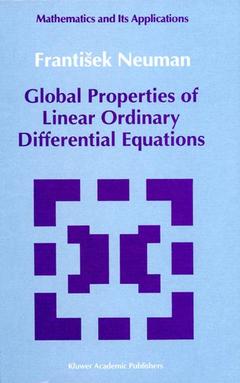Global Properties of Linear Ordinary Differential Equations, Softcover reprint of the original 1st ed. 1991 Mathematics and its Applications Series, Vol. 52
Langue : Anglais
Auteur : Neuman Frantisek

This monograph contains a description of original methods and results concern ing global properties of linear differential equations of the nth order, n ~ 2, in the real domain. This area of research concerning second order linear differential equations was started 35 years ago by O. Boruvka. He summarized his results in the monograph "Lineare Differentialtransforrnationen 2. Ordnung", VEB, Berlin 1967 (extended version: "Linear Differential Transformations of the Second Order", The English U niv. Press, London 1971). This book deals with linear differential equations of the nth order, n ~ 2, and summarizes results in this field in a unified fashion. However, this mono graph is by no means intended to be a survey of all results in this area. I t contains only a selection of results, which serves to illustrate the unified approach presented here. By using recent methods and results of algebra, topology, differential geometry, functional analysis, theory of functional equations and linear differential equations of the second order, and by introducing several original methods, global solutions of problems which were previously studied only locally by Kummer, Brioschi, Laguerre, Forsyth, Halphen, Lie, Stiickel and others are provided. The structure of global transformations is described by algebraic means (theory of categories: Brandt and Ehresmann groupoids), a new geometrical approach is introduced that leads to global canonical forms (in contrast to the local Laguerre-Forsyth or Halphen forms) and is suitable for the application of Cartan's moving-frame-of-reference method.
1. Introduction with historical remark.- 2. Notation, definitions and some basic facts.- 2.1 Generalities.- 2.2 Maps.- 2.3 Topology.- 2.4 Algebraic structures.- 2.5 Vector spaces.- 2.6 Linear differential equations.- 2.7 Functional equations.- 3. Global transformations.- 3.1 Definition of the global transformations.- 3.2 Smoothness of global transformations.- 3.3 Algebraic approach to global transformations.- 3.4 Fundamental problems.- 4. Analytic, algebraic and geometrical aspects of global transformation.- 4.1 Some useful formulas.- 4.2 Global transformations of special classes of linear differential equations.- 4.3 Covariant constructions of linear differential equations.- 4.4 Geometrical approach to global transformations.- 5. Criterion of global equivalence.- 5.1 Bor?vka’s criterion of global equivalence of the second order equations.- 5.2 Criterion of global equivalence of the third and higher order equations.- 6. Stationary groups.- 6.1 Notation and preliminary results.- 6.2 Preparatory results.- 6.3 Subgroups of stationary groups with increasing elements.- 6.4 Stationary groups with decreasing elements.- 6.5 Complete list of stationary groups and characterization of the corresponding equations.- 7. Canonical forms.- 7.1 Notion of canonical forms.- 7.2 The Laguerre-Forsyth and Halphen forms.- 7.3 Cartan’s moving-frame-of-reference method.- 7.4 Hereditary property.- 7.5 Global canonical forms: geometrical approach.- 7.6 Global canonical forms: analytic approach.- 7.7 List of canonical forms of the second and third order equations.- 8. Invariants.- 8.1 Notion of invariant and covariant.- 8.2 Covariants.- 8.3 Local invariants and covariants.- 8.4 Global invariants.- 8.5 Smoothness of coefficients as an invariant.- 9. Equations with solutions of prescribedproperties.- 9.1 Coordinate approach.- 9.2 Asymptotic properties of solutions of the second order equations.- 9.3 Periodic solutions of the second order equations.- 9.4 Geometrical approach.- 10. Zeros of solutions.- 10.1 Notation and definitions.- 10.2 Representation of zeros.- 10.3 Second order equations.- 10.4 Third order equations.- 10.5 Iterative nth order equations.- 10.6 Periodic solutions of nth order equations.- 11. Related results and some applications.- 11.1 Asymptotic properties and zeros of solutions of second order equations.- 11.2 Integral inequalities.- 11.3 Affine geometry of plane curves.- 11.4 Isoperimetric theorems.- 11.5 Related results and comments, possible trends of further research.- 12. Appendix: Two functional equations.- 12.1 Abel functional equation.- 12.2 Euler functional equation for homogeneous functions.- Literature cited in the book and/or for supplementary reading.- Index of names.
Date de parution : 11-2013
Ouvrage de 320 p.
17x24.4 cm
Mots-clés :
© 2024 LAVOISIER S.A.S.



